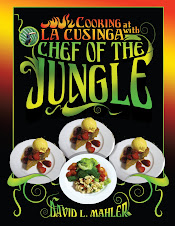I have been fortunate enough to have been able to enjoy dinner at what are considered to be two of the best, if not the best, restaurants in the Uvita-Ojochal area. Both are "jungle elegant", nicely appointed and touched with a European influence. The service at each leans toward formal, and if it doesn't quite accomplish serving the guest well, at least the intention is there. Each of these restaurants enjoys a great reputation, gets plenty of coverage in our local press and promotes themselves colorfully and expansively.
And while the food I had at one was markedly better than at the other, I was struck by something that I've been considering for a while, and attempting to overcome in my own kitchen. On each of my entree plates, the protein product was clearly the "star of the show", but the rest of the cast of characters, the starch and the vegetables, seemed lackluster, added as if they "had" to be there. And in fact, the vegetable accompaniments at each restaurant were exactly the same; a nicely arranged, but lukewarm (and unseasoned) combination of haricot vert, carrot, cauliflower and broccoli.
Additionally, at each of the restaurants, the starch accompaniments were a bland unseasoned white rice, mashed potatoes, or sauteed potatoes. There was no thought given to whether or not these starches represented an appropriate (God forbid they should be challenging or interesting) compliment to the protein product. Our choices of rice or potato were there simply because they "had" to be there. It would be unthinkable to put our an entree plate without rice or potatoes.
I had a Swiss couple in for dinner the other night and at the end of their meal they stopped by the kitchen to thank me and the woman made a comment that I appreciated and took as a form of confirmation. She told me that she enjoyed that my plates were "balanced". I asked her what she meant and she remarked that it was clear to her that each of the items on her plate carried equal importance in the construction of the dish. I had served her fresh shrimp sauteed with a roasted tomato sauce on risotto; a mix of braised organic greens, sauteed Chinese long beans with garlic, and steamed cauliflower florets.
This attention to the full plate is what I am striving for and what I wish I could see more of in other restaurants that I visit. We live in an area rich with a wide variety of fruits and vegetables; too rich to allow us to limit ourselves to "safety cooking". This concept of letting the protein product and its sauce be the "main attraction" is an old school notion and addresses neither an awareness of the way people are eating, or an awareness of the way cuisine is shifting.
I believe it is incumbent upon those of us who have chosen to be Chefs to take responsibility for many aspects of our guest's experience in our dining rooms. Comfort, yes; escape, yes; satisfaction, naturally. But moreover, we have responsibility to help our diners to explore new regions and new sensations. We have a responsibility to the health of our diners, physically and spiritually. Certainly, the guest wants and needs a "comfort zone" experience from time to time and he should know where to go to get it.
At La Cusinga, however, I will continue to buy the best, freshest and sometimes the oddball ingredient from my farmers. I will continue to place an equal value on everything I place on my plates. And I will continue to encourage my guests to open their palates, open their eyes and, most importantly, their minds. Dining out should be a fresh, bright experience, not sadly predictable.














Nice post, Chef. You know I am a cranky vegetarian on this very topic. Although the FDA has lowered daily protein guidelines over the years, we continue to live in a meat-centric cultural which has become the global norm. Politics of food another time.
ReplyDeleteIt matters not to me what others choose to eat, but it makes all kinds of sense that animal protein is best as a side, garnish or a balanced part of a dish, such as your guest noted about your entree.
Out of habit, a dish is described *first* by the protein. What if you were to say, "Risotto with Roasted Local Tomatoes and Shrimp, and Braised...?" You could start a quiet revolution.
Freedom for vegetables from same-old!
XO,
Christine